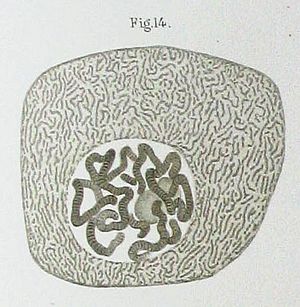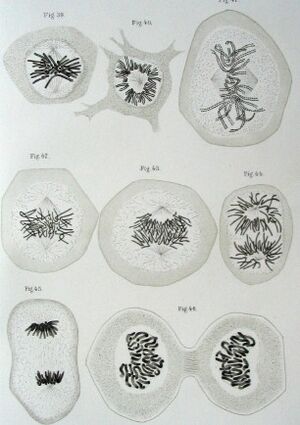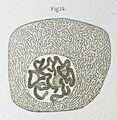Walther Flemming facts for kids
Quick facts for kids
Walther Flemming
|
|
|---|---|
 |
|
| Born | 21 April 1843 Sachsenberg, Mecklenburg-Schwerin, Germany
|
| Died | August 4, 1905 (aged 62) Kiel, Germany
|
| Education | University of Rostock, University of Prague |
| Known for | Cytogenetics, mitosis, chromosomes, chromatin |
| Parent(s) | Carl Friedrich Flemming and Auguste Winter |
| Scientific career | |
| Institutions | University of Prague, University of Kiel |
Walther Flemming (born April 21, 1843 – died August 4, 1905) was an important German biologist. He is known as one of the founders of cytogenetics, which is the study of how cells work, especially their genes.
Walther Flemming was born in Sachsenberg, which is now part of Schwerin, Germany. He was the fifth child and only son of Carl Friedrich Flemming, who was a psychiatrist. Walther went to the Gymnasium der Residenzstadt school. There, he became good friends with the writer Heinrich Seidel.
Contents
Becoming a Scientist
Walther Flemming studied medicine at the University of Prague. He finished his studies in 1868. After that, he worked as a doctor for the military during the Franco-Prussian War from 1870 to 1871.
From 1873 to 1876, he taught at the University of Prague. In 1876, he became a professor of anatomy at the University of Kiel. He also became the director of the Anatomical Institute there. He worked at the University of Kiel until he passed away.
Discovering Chromosomes
Flemming used special aniline dyes to study cells. He found a structure inside cells that soaked up these dyes very strongly. He called this material chromatin.
He realized that chromatin was connected to tiny, thread-like structures inside the cell nucleus. These structures were later named chromosomes. The word "chromosome" means "coloured bodies" because they absorbed the dyes. Another scientist, Wilhelm von Waldeyer-Hartz, gave them this name. The Belgian scientist Edouard Van Beneden also saw these structures around the same time.
Understanding Cell Division
Flemming spent a lot of time studying how cells divide. He looked at how chromosomes were shared when a cell split into two new cells. He called this amazing process mitosis. The word "mitosis" comes from a Greek word meaning "thread," because of the thread-like chromosomes.
He studied mitosis in living cells and in prepared samples. He often used the fins and gills of salamanders for his research. He first shared his findings in 1878. Then, in 1882, he published a very important book called Zellsubstanz, Kern und Zelltheilung. This title means "Cell substance, nucleus and cell division."
Based on his discoveries, Flemming was the first to suggest that every cell nucleus comes from another nucleus that existed before it. He created the phrase omnis nucleus e nucleo, which means "every nucleus from a nucleus." This idea was similar to Rudolf Virchow's famous saying, "every cell from a cell."
Flemming's Legacy
Walther Flemming did not know about the work of Gregor Mendel on heredity (how traits are passed down). So, he didn't connect his discoveries about chromosomes to how genes are inherited. It took about twenty more years for scientists to fully understand how important Flemming's work was, after Mendel's rules were rediscovered.
The Science Channel recognized Flemming's discovery of mitosis and chromosomes as one of the 100 most important scientific discoveries ever. They also called it one of the top 10 most important discoveries in cell biology.
Today, the German Society for Cell Biology honors Flemming's name with a special medal.
Images for kids
See also
 In Spanish: Walther Flemming para niños
In Spanish: Walther Flemming para niños





